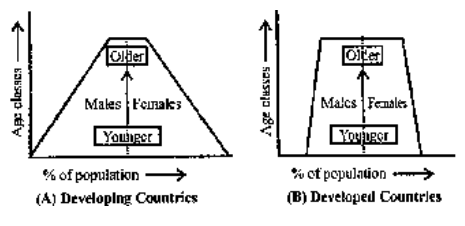Population Growth Rate
Human Population of Class 12
Population Growth Rate
Population growth rate the number of individuals added to the population either through birth or through immigration minus the number of individual lost by death or emigration.
In stable population number of individuals added equals the number of individuals lost and growth rate is zero or remain constant.
Growth rate = (Birth rate + Immigrants) – (Death rate + Emigrants)
Zero Population Growth
Both natality and mortality rate are equal, and hence population growth is zero i.e., - population size remain constant; also called Zero
Population Growth or Demographic Transition.
Birth rate + Immigrants = Death rate + Emigrants.
Bio-index Number
Ratio of birth rate to death rate. In zero population growth the bio-index number is one.
Bio-index number =
Carrying Capacity
Maximum number of individuals which can be supported by environment for their survival. In the absence environmental resistance population growth occurs in exponential manner and the curve is J-shaped.
With limited resources and area the environmental resistance operates and doesn’t allow the population growth to infinity. Thus, the population growth curve increases exponentially only initially and after that environmental resistance checks the growth. The resulting growth curve is S- shaped and called sigmoid curve. All environments can sustain only limited size of population; limit is constant K and called carrying capacity.
Population Density
Number of individuals present per unit area at a given time.
 ,where D is density ; N is number, S is space (area); expressed (m2) for land organisms and as (m3) for aquatic and aerial organisms.
,where D is density ; N is number, S is space (area); expressed (m2) for land organisms and as (m3) for aquatic and aerial organisms.
Sex-ratio
Number of females per thousand males.
Age and Sex Structure
Proportion of individuals of different age and sex. Depicted in pyramidal form plotting percentage of population of each sex in each age-class.
In developing countries, like India, it is less steep as it has a larger number of younger people. In developed countries it is steeper as represents nearly stable population.

Fig. Age Sex Ratio in Developing and Developed Countries
Table : Present population
Present population of the world - ~ 6.1 Billion
Most populous country - China (1.28 Billion)
Second most populous country - India (1.03 Billion)
Most densely populated country - Monaco (45,483 / km2)
Second densely populated country - Bangladesh
Least populated country - Vatican city
Least densely populated country - Greenland (1/45 km2)
Second least densely populated country - Australia (2 km2)
Table : India’s Population (as per census of 2001)
Present population - 1.02 Billion
Population density - 324 / Km2
Sex ratio - 933 females per 1,000 males.
Growth rate - 21.34 (2.13%)
Life expectancy - 62.3 yrs (Male), 65.27 (Female)
Most populated state - U.P (16.17% of India’s population) (only 4 countries, i.e. China, USA, Indonesia and Brazil have population more than that of U.P.)
Most populous city - Mumbai
Maximum density - Delhi (9294/Km2) (in states W.Bengal - 904/Km2)
Minimum density - Arunachal Pradesh (13 / Km2)









